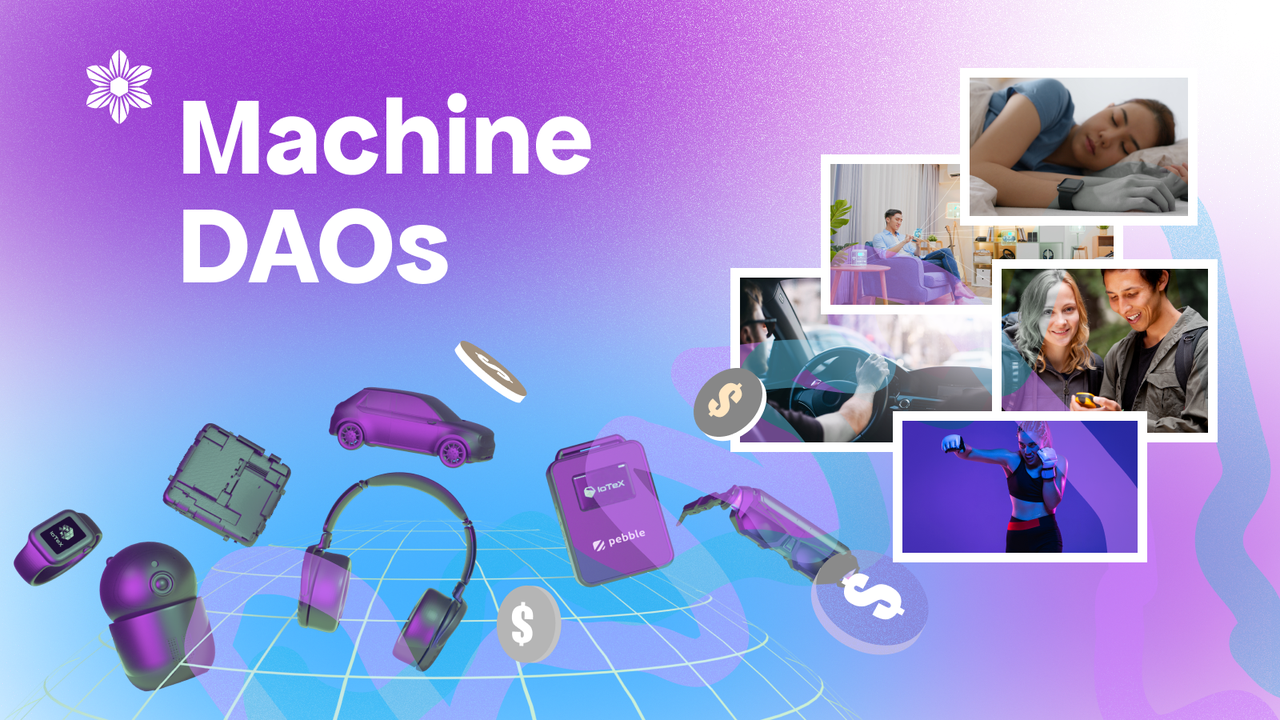Connecting the Real World to Web3 - MachineFi Use Cases

Over the past few years, Web3 has captured the attention of millions via DeFi, GameFi, NFTs, DAOs, and other use cases. However, we believe the key to mass adoption is connecting the real world to Web3 via the combination of blockchain and the Internet of Things (IoT). By using smart devices to prove users' real-world activities, people around the world can earn cryptocurrency by completing tasks in the physical world that improve their lives or benefit society. Unlike the digital-focused industries that Web3 has disrupted thus far, the real world economy is significantly greater in size and scope -- a multi-trillion dollar opportunity awaits for the budding #MachineFi sector.
In this blog, we explain the exciting universe of #MachineFi use cases that will be enabled by IoTeX and W3bstream.
Proof of Anything
Proof of Work (PoW) and Proof of Stake (PoS) are common terms in crypto -- under these consensus mechanisms, users submit proofs of computational work and financial stake, respectively, to the blockchain in order to earn the right to mint blocks on behalf of the network and earn mining rewards. But what if the proofs that users submit to a blockchain were not limited to proofs of digital activity but could also include proofs of real-world activity?
By 2030, there will be 100 billion devices in the world that watch, listen, and sense to our real-world activities. Just like Chainlink establishes a "single version of the truth" of cryptocurrency prices for DeFi, W3bstream uniquely establishes a “single version of the truth” of events that happen in the real world for #MachineFi. All types of devices/machines can be integrated into W3bstream and contribute their sensor data to Dapps as Proof of Anything.
Proof of Anything, enabled by W3bstream, is a foundational building block for #MachineFi use cases and opens up a brand new design space for Web3 builders. W3bstream acts as a translation layer between the real world and Web3, generating proofs of real-world activity based on smart device data that instructs the blockchain to deliver token-incentives to users that complete various incentivized tasks. Whether it is proving you've burned 1,000 calories via your Apple Watch, contributed data from your weather station to a decentralized weather index, or produced energy with your solar panel that is added to a decentralized energy grid, Proof of Anything is the foundation to power Web3 incentive models for #MachineFi Dapps.
In the next sections, we explore several types of Web3 incentive models / use case categories: X-and-Earn, decentralized data pools, and Machine DAOs.
X-and-Earn
Today's world is powered by disincentives where people are penalized for doing bad things; for example, if you are a bad driver your insurance rate will go up or if you pollute the environment you will get fined. But what if instead we could be incentivized and rewarded for doing things well? This is the psychological foundation for X-and-Earn. By delivering micro-incentives in the form of tokens or NFTs, people can be incentivized to improve their personal lives, the environment, and more on a daily basis. These incentives may come from your insurance company, employer, or government and can drive behavioral change in a permissionless fashion.

This past year, projects like HealthBlocks, Step'n and DIMO pioneered the first examples of Walk-and-Earn and Drive-and-Earn use cases, where users earn cryptocurrency by submitting data from their healthcare wearables and vehicles to prove completion of daily challenges that show they've improved their health or driving. But the landscape for X-and-Earn is much larger than just health and driving -- from reducing the energy used in your smart home to attending in-person events to recycling plastic bottles, all of these activities can be proven by smart devices and rewarded with Web3 incentives.
X-and-Earn use cases typically involve a single device from a single owner, where proofs of everyday activities can be rewarded with cryptocurrency.
Decentralized Data Pools
If data is the new gold, then smart devices are the goldmines. The global data market already exceeds $100 billlion in value and data is the lifeblood of the world's largest corporations, such as Google and Facebook, who have built trillion-dollar businesses on top of users' data. However, these trillions of dollars in value are not shared with users; to the contrary, users' data is exploited by corporations that utilize our sensitive data for their own profits. Web3 and MachineFi provide a once-in-a-lifetime opportunity to take back ownership of our data and capture our fair share of the massive data economy.

Although a single person's data is not worth much today, the value of data grows exponentially when data from many users collected over longer periods of time is combined together to form a time-series database. This is because of network effects and the ability to extract deeper and more valuable insights from large datasets that have diverse consituents and time duration. By incentivizing people to continuously submit their data with Web3 token incentives, we can recreate the billion-dollar datasets that Big Tech has constructed but from a bottoms-up, user-governed approach. This is especially true for data from our smart devices, which capture all types of insights regarding people, cities, the environment, and more. Some examples of emerging decentralized data pool projects include Elumicate, WeatherXM, and PlanetWatch. which focus on crowdsourcing environmental data.

Decentralized data pools are very similar to decentralized exchanges (DEXs) -- instead of crowdsourcing liquidity to form a liquidity pool, data is crowdsourced to form a data pool. Just like a DEX, those that contribute data to a data pool will receive a portion of revenues proportional to the amount of data you provided. The more value the data pool generates, the more profits are earned by data contributors, which introduces a flywheel effect and incentivizes further growth of the data pool. The opportunities to extract insights from decentralized data pools are widespread, including training artificial intelligence (AI) models, predictive analytics, data simulations, and much more.
Decentralized data pools involve multiple devices from multiple owners. Data is crowdsourced to form a community-owned data product where any revenues generated are shared proportionally with device owners / data contributors.
Machine DAOs (Community-Owned Machine Network)
Smart devices not only generate data, but can also deliver services in the real world. As robotics and automation technology advances year-by-year, machines will increasingly replace human work and become an enormous part of the real world economy. The World Economic Forum estimates that by 2025 over 60 million human jobs will be replaced by machines. As this new machine economy expands into our personal and professional lives, an incredibly important question surfaces: who will own these machines and the value they create?

Machine DAOs are community-owned machine networks that consist of user-owned machines that are orchestrated by a blockchain to create a public utility or public service that anyone can utilize for a fee. From drones that capture aerial imagery to hotspots that deliver connectivity to solar panels that produce energy to vending machines that drive commerce to robo-taxis that deliver rides, users will be able to contribute machines they own into a Machine DAO to earn revenue. Whether it is a machine you own that you want to lend to others when its not in use, such as a drone or autonomous vehicle, or a machine that you purchase solely to generate revenue, such as a vending machine or solar panel, the concept of Machine DAOs will enable everyday people to generate passive income by providing machine-as-a-service.
Not only will blockchains manage transactions and payments from machine-as-a-service buyers to machine owners, they will also add much-needed trust and transparency to the machine economy. Although this may seem futuristic, Web3 projects like Helium, Spexigon and React are starting to build the first Machine DAOs for connectivity hotspots, drones, and solar panels. By combining tamper-proof hardware (i.e., blockchain-registered machines) with tamper-proof software (i.e., smart contracts), the future machine economy can be governed and controlled by users, not corporations or governments.

Machine DAOs involve multiple devices/machines from multiple owners. User-owned machines can be registered to a DAO and earn revenues on behalf of their owners by providing "machine-as-a-service".
What's Next?
Starting in 2017, IoTeX has been on a mission to combine Blockchain & IoT to empower the decentralized machine economy. With our latest W3bstream release, IoTeX is enabling Web3 builders to seamlessly connect smart devices to smart contracts for the very first time. We encourage anyone that is interested in building MachineFi Dapps on this revolutionary infrastructure to check out our Halo Grants program and review the latest happenings on the IoTeX Developer Portal.
Over the coming weeks, we will publish deep-dive reports on X-and-Earn, decentralized data pools, and Machine DAOs that detail the emerging tokenomics models and technological architectures that will fuel these exciting use case categories. Stay tuned!